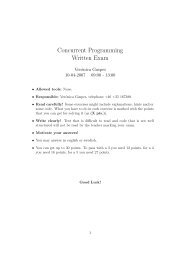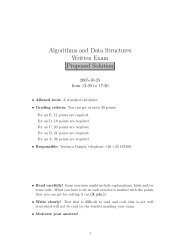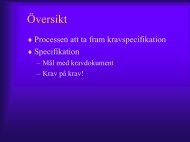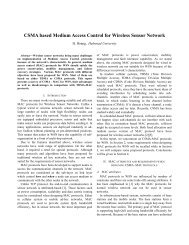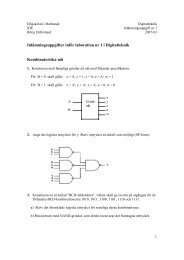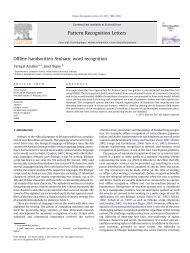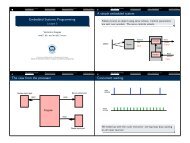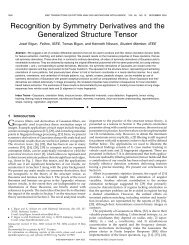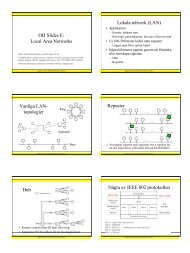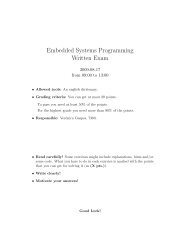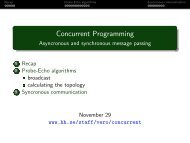HMM-Based Handwritten Amharic Word Recognition with Feature ...
HMM-Based Handwritten Amharic Word Recognition with Feature ...
HMM-Based Handwritten Amharic Word Recognition with Feature ...
Create successful ePaper yourself
Turn your PDF publications into a flip-book with our unique Google optimized e-Paper software.
2009 10th International Conference on Document Analysis and <strong>Recognition</strong><br />
<strong>HMM</strong>-<strong>Based</strong> <strong>Handwritten</strong> <strong>Amharic</strong> <strong>Word</strong> <strong>Recognition</strong> <strong>with</strong><br />
<strong>Feature</strong> Concatenation<br />
Yaregal Assabie and Josef Bigun<br />
School of Information Science, Computer and Electrical Engineering<br />
Halmstad University, Halmstad, Sweden<br />
{yaregal.assabie, josef.bigun}@hh.se<br />
Abstract<br />
<strong>Amharic</strong> is the official language of Ethiopia and<br />
uses Ethiopic script for writing. In this paper, we<br />
present writer-independent <strong>HMM</strong>-based <strong>Amharic</strong> word<br />
recognition for offline handwritten text. The<br />
underlying units of the recognition system are a set of<br />
primitive strokes whose combinations form<br />
handwritten Ethiopic characters. For each character,<br />
possibly occurring sequences of primitive strokes and<br />
their spatial relationships, collectively termed as<br />
primitive structural features, are stored as feature list.<br />
Hidden Markov models for <strong>Amharic</strong> words are trained<br />
<strong>with</strong> such sequences of structural features of<br />
characters constituting words. The recognition phase<br />
does not require segmentation of characters but only<br />
requires text line detection and extraction of structural<br />
features in each text line. Text lines and primitive<br />
structural features are extracted by making use of<br />
direction field tensor. The performance of the<br />
recognition system is tested by a database of<br />
unconstrained handwritten documents collected from<br />
various sources.<br />
1. Introduction<br />
<strong>Amharic</strong> is the official language of Ethiopia which<br />
has a population of over 80 million at present. It<br />
belongs to Afro-Asiatic language family, and today it<br />
has become the second most widely spoken Semitic<br />
language in the world, next to Arabic. Along <strong>with</strong><br />
several other Ethiopian languages, <strong>Amharic</strong> uses<br />
Ethiopic script for writing. The Ethiopic script used by<br />
<strong>Amharic</strong> has 265 characters including 27 labialized<br />
(characters mostly representing two sounds, e.g. for<br />
) and 34 base characters <strong>with</strong> six orders<br />
representing derived vocal sounds of the base<br />
character. The alphabet is written in a tabular format of<br />
seven columns where the first column represents the<br />
base characters and others represent their derived vocal<br />
sounds. Part of the alphabet is shown in Table 1.<br />
Table 1. A sample of handwritten Ethiopic characters.<br />
Orders<br />
Base<br />
Sound<br />
1 h<br />
2 l<br />
3 h<br />
4 m<br />
5 s<br />
.<br />
.<br />
.<br />
.<br />
.<br />
.<br />
32 f<br />
33 p<br />
34 v<br />
1st<br />
(ä)<br />
2 nd<br />
(u)<br />
3 rd<br />
(i)<br />
4 th<br />
(a)<br />
5 th<br />
(e)<br />
6 th<br />
()<br />
7 th<br />
(o)<br />
Automatic recognition of unconstrained<br />
handwritten text is one of the most challenging pattern<br />
recognition problems due to the varying nature of the<br />
data. With respect to this inherent nature, various<br />
recognition methods have been proposed. Offline<br />
recognition of Latin, Chinese, Indian, and Arabic<br />
handwritten text has long been an area of active<br />
research and development [3], [4]. However, Ethiopic<br />
handwriting recognition in general, and <strong>Amharic</strong> word<br />
recognition in particular, is one of the least<br />
investigated problems. The difficulty in automatic<br />
recognition of Ethiopic script arises from the relatively<br />
large number of characters, their interclass similarity<br />
and structural complexity. In this paper, we present<br />
<strong>Amharic</strong> word recognition in unconstrained<br />
handwritten text using hidden Markov model (<strong>HMM</strong>).<br />
978-0-7695-3725-2/09 $25.00 © 2009 IEEE<br />
DOI 10.1109/ICDAR.2009.50<br />
961
2. Description of the <strong>Recognition</strong> System<br />
Originally applied to the domain of speech<br />
recognition, <strong>HMM</strong>s have emerged as a powerful<br />
paradigm for modeling pattern sequences in different<br />
areas such as online handwriting recognition. Inspired<br />
by the success in such fields, they have attracted a<br />
growing interest more recently in various computer<br />
vision applications including offline handwriting<br />
recognition [3], [4], [5].<br />
2.1. Theoretical background<br />
<strong>HMM</strong>s are doubly stochastic processes which<br />
model time varying dynamic patterns. The system<br />
being modeled is assumed to be a Markov process that<br />
is hidden (not observable), but can be observed<br />
through another stochastic process that produces the<br />
sequence of observations. The hidden process consists<br />
of a set of states connected to each other by transitions<br />
<strong>with</strong> probabilities, while the observed process consists<br />
of a set of outputs or observations, each of which may<br />
be emitted by states according to some output<br />
probability density function. <strong>HMM</strong>s are characterized<br />
by the following parameters [5]:<br />
N, the number of states in the model. Individual<br />
states are denoted as S ={S 1 ,S 2 , … , S N }, where the<br />
state at time t is denoted as q t .<br />
M, the number of distinct observation symbols per<br />
state, denoted as V = {v 1 , v 2 , … , v M }.<br />
A={a ij }, the state transition probability distribution<br />
where a ij = P[q t+1 = S j | q t = S i ], 1
( ), and 112233 ( ). The classification and definition<br />
of these structural features is further exposed in [1]. A<br />
spatial relationship between two primitives is defined<br />
to have six feature values where a value of zero is<br />
padded at the beginning for those whose number of<br />
connections are two or less. For example, the feature<br />
value of a spatial relationship of the type 13 ( ) will<br />
be {0,0,0,0,1,3}. The sequential order of primitive<br />
strokes and is set as AB if is spatially located at<br />
the left or top of . However, if A and B are both<br />
connected to the right of another primitive stroke and<br />
A is located at the top of B, their sequential order is<br />
represented as BA. Each primitive is connected to<br />
another one to the left except the first primitive in each<br />
character, in which case it does not have any one to be<br />
connected to the left. In such cases, all the six feature<br />
values for such spatial relationship will be all zeros.<br />
2.3. Training and recognition<br />
The goal of the training phase is to estimate the<br />
parameter values of word models from a set of training<br />
samples, and the recognition phase decodes the word<br />
based on the observation sequence. In this work,<br />
Baum-Welch algorithm is used for training and Viterbi<br />
algorithm is used for recognition. A simplified<br />
flowchart of training and recognition procedures is<br />
shown in Fig. 1. The dotted-line box in the flowchart<br />
shows repetitive tasks for each word.<br />
Input word<br />
Generation of sample<br />
word features<br />
<strong>HMM</strong> initialization<br />
Model training<br />
Characters’<br />
features<br />
Master<br />
model<br />
file<br />
<strong>Handwritten</strong> text<br />
Text line detection and<br />
word segmentation<br />
Model recognition<br />
Output word<br />
<strong>Feature</strong> extraction<br />
Figure 1. Training and recognition flowchart.<br />
Training samples for a given word are generated<br />
from the stored feature lists of characters which<br />
contain possibly occurring sample features each<br />
Ethiopic character. A character can have many sample<br />
features stored as character feature list reflecting<br />
variations of writing styles. Suppose that the input<br />
word W has sequences of characters C 1 , C 2 , C 3 ,…,C m ,<br />
where m is the total number of characters making up<br />
the word. Then, sample features of the word are<br />
generated as all combinations of sample features of<br />
each character. Figure 2 shows a sample feature for<br />
the word “” generated from the character features.<br />
Each group in the rectangular box beneath characters<br />
represents sample features for the corresponding<br />
character, whereas each line represents a feature vector<br />
of primitives and their associated spatial relationships.<br />
Characters’ features<br />
<br />
0 0 0 0 0 0 8 8 9<br />
0 0 0 0 3 1 8 8 7<br />
0 0 0 0 2 1 8 8 7<br />
0 0 0 0 0 0 6 7 9<br />
0 0 0 0 3 1 8 8 7<br />
0 0 0 0 2 1 8 8 7<br />
.<br />
0 0 0 0 0 0 6 7 9<br />
0 0 0 0 1 1 9 8 8<br />
.<br />
0 0 0 0 0 0 9 8 8<br />
0 0 0 0 3 2 6 7 7<br />
0 0 0 0 1 1 6 7 9<br />
0 0 0 0 0 0 9 8 8<br />
0 0 0 0 3 2 6 7 7<br />
0 0 0 0 1 2 6 7 9<br />
Sample feature for the word “”<br />
0 0 0 0 0 0 8 8 9 0 0 0 0 3 1 8 8 7 0 0 0 0 2 1 8 8 7<br />
0 0 0 0 0 0 6 7 9 0 0 0 0 1 1 9 8 8<br />
0 0 0 0 0 0 9 8 8 0 0 0 0 3 2 6 7 7 0 0 0 0 1 2 6 7 9<br />
Figure 2. Generation of sample feature for “”.<br />
After generating sample features for the input word,<br />
the next procedure is <strong>HMM</strong> initialization which sets a<br />
prototype for <strong>HMM</strong> of the word to be trained including<br />
its model topology, transition and output distribution<br />
parameters. Gaussian probability function that consists<br />
of means and variances is used to define the model<br />
parameters. The number of states of a word<br />
corresponds to the total number of primitive strokes in<br />
the word. The <strong>HMM</strong> topology of “” which has<br />
eight primitive strokes is shown in Fig. 3. Once the<br />
<strong>HMM</strong> is trained <strong>with</strong> sample features of the word, the<br />
model is stored into a master model file which will be<br />
used later during the recognition phase.<br />
In the recognition phase, handwritten text image is<br />
processed to detect lines and segment words. For each<br />
word in the text image, a sequence of primitive strokes<br />
and their spatial relationship is extracted. Figure 4<br />
shows primitive strokes and spatial relationships<br />
identified for the handwritten word “ ”. Then, the<br />
.<br />
963
a 11 a 22 a 33 a 44 a 55 a 66 a 77 a 88 significant eigenvector modulated by the error<br />
differences (the difference of eigenvalues). This vector<br />
field is also known as the linear symmetry (LS) vector<br />
a 12 a 22 a 34 a 45 a 56 a 67 a 78 field and can be obtained directly by use of complex<br />
1 2 3 4 5 6 7 8<br />
a 13 a 24 a 35 a 46 a 57 a 68<br />
moments. The latter are defined as:<br />
m<br />
n<br />
Imn = (( Dx<br />
+ iDy)<br />
f ) (( Dx<br />
− iDy<br />
<br />
) f ) dxdy (2)<br />
b 1 ( ) b 2 ( ) b 3 ( ) b 4 ( ) b 5 ( ) b 6 ( ) b 7 ( ) b 8 ( ) where m and n are non-negative integers. Among other<br />
orders, of interest to us are I10, I11, and I20 derived as:<br />
Figure 3. <strong>HMM</strong> topology for the word “”.<br />
I10<br />
= (( D iD ) f dxdy (3)<br />
sequence is generated as: {{, , },{, },<br />
{, , }}, where the Greek capital letters<br />
represent primitive strokes and smaller letters represent<br />
associated spatial relationships. Note that , , and <br />
are not shown in the figure since they correspond to a<br />
spatial relationship of the first primitive stroke in each<br />
character, in which they do not have primitive to the<br />
left to be connected <strong>with</strong>. Once structural features are<br />
identified and classified, they are assigned <strong>with</strong> feature<br />
values as discussed in Section 2.2. Then, the extracted<br />
feature sequences are considered as observations<br />
which are used by the decoder for recognition.<br />
<br />
<br />
<br />
<br />
<br />
<br />
Figure 4. Structural features for the word “ ”.<br />
3. <strong>Feature</strong> Extraction<br />
The recognition system requires text lines, words<br />
and pseudo-characters to be segmented for analysis.<br />
We developed an algorithm for such segmentation<br />
tasks using direction field image. Pseudo-characters<br />
represent two or more physically connected characters,<br />
but hereafter we simply refer to them as characters.<br />
3.1. Computation of direction field image<br />
Direction field tensor S is a 2x2 matrix which<br />
computes the optimal direction of pixels in a local<br />
neighborhood of an image f [2]. It is computed as:<br />
2<br />
<br />
<br />
<br />
(Dx<br />
f) dxdy (Dx<br />
f)(Dy<br />
f)dxdy<br />
S =<br />
<br />
2<br />
(1)<br />
(Dx<br />
f)(Dy<br />
f)dxdy (Dy<br />
f) dxdy <br />
The integrals are implemented as convolutions <strong>with</strong><br />
a Gaussian kernel, and Dx and Dy are derivative<br />
operators. The local direction vector is the most<br />
<br />
<br />
<br />
<br />
<br />
I<br />
I<br />
+<br />
( Dx<br />
+<br />
(( Dx<br />
+<br />
x y )<br />
= iD f dxdy<br />
11<br />
y<br />
)<br />
2<br />
= iD ) f dxdy<br />
20 y )<br />
In a local neighborhood of an image, I10 computes<br />
the ordinary gradient field; I11 measures gray value<br />
changes (the sum of eigenvalues of S); and I20 gives a<br />
complex value where its argument is the optimal<br />
direction of pixels in double angle representation and<br />
its magnitude is the local LS strength (the difference of<br />
eigenvalues of S). Pixels <strong>with</strong> low magnitude are said<br />
to be lacking LS property. As shown in Fig. 5, I10 and<br />
I20 images can be displayed in color where the hue<br />
represents direction of pixels <strong>with</strong> the red color<br />
corresponding to the direction of zero degree.<br />
(a) (b) (c) (d)<br />
Figure 5. (a) <strong>Handwritten</strong> , (b) I10, (c) I20, (d) I11 of a.<br />
3.2. The segmentation process<br />
Segmentation and text line detection is done on the<br />
direction field image (I20) in two passes. In the first<br />
pass, the image is traversed from top to down and<br />
pixels are grouped into two as blocked (character) and<br />
open (background) regions. A pixel is recursively<br />
classified as open if it:<br />
is in the first row of the direction field image,<br />
lacks LS and one of its immediate top and/or<br />
sideways neighborhood is open.<br />
The remaining are grouped as blocked pixels.<br />
Boundaries of blocked regions produce segmented<br />
characters. In the second pass, the I20 image is<br />
traversed from left to right grouping each segmented<br />
character into appropriate text lines based on<br />
character’s proximity along global (average direction<br />
of the text line) and local (direction at the head of the<br />
text line) directions. Segmented characters that do not<br />
fit into the existing text lines form a new text line. The<br />
directions of a text line help to predict the direction in<br />
2<br />
(4)<br />
(5)<br />
964
which the next member character is found during<br />
traversal, which is essential especially in skewed<br />
documents and non-straight text lines. Figure 6 shows<br />
segmentation and text line detection for handwritten<br />
<strong>Amharic</strong> text skewed by 15 o . <strong>Word</strong>s are then<br />
segmented based on the relative gap R between<br />
characters <strong>with</strong>in a text line, defined as R i = G i – G i-1 ,<br />
where G i is the horizontal gap between the i th character<br />
and its predecessor. Although the horizontal gap<br />
between consecutive characters varies greatly, the<br />
relative gap suppresses those variations and a threshold<br />
segments words fairly well.<br />
Figure 6. Results of (a) character segmentation,<br />
and (b) text line detection.<br />
Pixels are grouped as parts of primitives and<br />
connectors based on their optimal direction. After<br />
halving the double angle of I20, pixels having LS<br />
properties and directions of [0..60] or [120..180]<br />
degrees are set as parts of primitives whereas those<br />
<strong>with</strong> LS properties and having directions of (60..120)<br />
degrees are considered as parts of connectors. The<br />
extracted linear structures in the I20 image are mapped<br />
onto the I10 image to classify them into left and right<br />
edges of primitives. A primitive is then formed from<br />
the matching left and right edges. Primitives are then<br />
further classified using their direction, relative length,<br />
and spatial position.<br />
4. Experiment<br />
To test the performance of the system, a database<br />
of handwritten <strong>Amharic</strong> documents collected from 177<br />
writers is developed. The writers were provided <strong>with</strong><br />
<strong>Amharic</strong> documents dealing <strong>with</strong> various real-life<br />
issues and they used ordinary pen and white papers for<br />
writing. A total of 307 pages were collected and<br />
scanned at a resolution of 300dpi, from which we<br />
extracted 10,932 distinct words to build a list of words<br />
for training. For filtering operations of scanned texts, a<br />
symmetric Gaussian of 3x3 pixels was used. Training<br />
and recognition of <strong>HMM</strong>s were implemented by using<br />
the HTK toolkit. <strong>Recognition</strong> rates show variations<br />
(a)<br />
(b)<br />
due to the quality of the handwriting and number of<br />
training words. Documents are classified as good and<br />
poor based on their quality such as readability and<br />
connectivity of characters and words. The most<br />
frequent 10 and 100 words were also used for training<br />
and testing the system <strong>with</strong> different sizes. The result<br />
is summarized in Table 3.<br />
Table 3. <strong>Recognition</strong> result.<br />
Quality of text<br />
Number of training words<br />
10 100 10,932<br />
Good 98% 93% 76%<br />
Poor 85% 81% 53%<br />
5. Discussion and Conclusion<br />
<strong>HMM</strong>-based <strong>Amharic</strong> word recognition system for<br />
handwritten text is presented. Script-independent text<br />
line detection, and character and word segmentation<br />
algorithms are also presented. Our proposed method<br />
generates sample features of training words from a<br />
stored feature list of characters. The feature list stores a<br />
variety of sample features for each character reflecting<br />
different real-world writing styles. The advantage of<br />
this is that it is possible to produce real-world sample<br />
word features for any word <strong>with</strong>out collecting sample<br />
text, which is turned out to be writer-independent<br />
recognition system. It also means that the system can<br />
be directly applied for other Ethiopian languages<br />
which use Ethiopic script for writing. Since we are<br />
encoding the relative size of primitive strokes,<br />
recognition system does not require size normalization.<br />
The recognition result can be further improved by<br />
working more on extraction of structural features and<br />
employing language models to <strong>HMM</strong>s. The database<br />
we developed can be used as a benchmark resource for<br />
further studies on recognition of Ethiopic script.<br />
References<br />
[1] Y. Assabie and J. Bigun, " Writer-independent offline<br />
recognition of handwritten Ethiopic characters", In:<br />
Proc. 11 th ICFHR, Montreal, pp. 652-656, 2008.<br />
[2] J. Bigun, Vision <strong>with</strong> Direction: A Systematic<br />
Introduction to Image Processing and Vision. Springer,<br />
Heidelberg, 2006.<br />
[3] B. B. Chaudhuri (Ed.), Digital Document Processing:<br />
Major Directions and Recent Adavances, Springer,<br />
ISBN 978-1-84628-501-1, London, pp. 165-183, 2007.<br />
[4] R. Plamondon, S.N. Srihari, “On-line and off-line hand<br />
writing recognition: A comprehensive survey”, IEEE<br />
Trans. PAMI, 22(1): pp. 63-84, 2000.<br />
[5] R. Rabiner, “A Tutorial on Hidden Markov Models and<br />
Selected Applications in Speech <strong>Recognition</strong>”, Proc.<br />
IEEE , 77( 2), pp. 257-286, 1989.<br />
965



